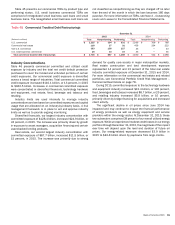Bank of America 2015 Annual Report Download - page 73
Download and view the complete annual report
Please find page 73 of the 2015 Bank of America annual report below. You can navigate through the pages in the report by either clicking on the pages listed below, or by using the keyword search tool below to find specific information within the annual report.
Bank of America 2015 71
Purchased Credit-impaired Loan Portfolio
Loans acquired with evidence of credit quality deterioration since
origination and for which it is probable at purchase that we will be
unable to collect all contractually required payments are accounted
for under the accounting guidance for PCI loans, which addresses
accounting for differences between contractual and expected cash
flows to be collected from the purchaser’s initial investment in
loans if those differences are attributable, at least in part, to credit
quality. For more information on PCI loans, see Note 1 – Summary
of Significant Accounting Principles to the Consolidated Financial
Statements.
Table 30 presents the unpaid principal balance, carrying value,
related valuation allowance and the net carrying value as a
percentage of the unpaid principal balance for the PCI loan
portfolio.
Table 30 Purchased Credit-impaired Loan Portfolio
December 31, 2015
(Dollars in millions)
Unpaid
Principal
Balance
Gross
Carrying
Value
Related
Valuation
Allowance
Carrying
Value Net of
Valuation
Allowance
Percent of
Unpaid
Principal
Balance
Residential mortgage $ 12,350 $ 12,066 $ 338 $11,728 94.96%
Home equity 4,650 4,619 466 4,153 89.31
Total purchased credit-impaired loan portfolio $ 17,000 $ 16,685 $ 804 $15,881 93.42
December 31, 2014
Residential mortgage $ 15,726 $ 15,152 $ 880 $ 14,272 90.75%
Home equity 5,605 5,617 772 4,845 86.44
Total purchased credit-impaired loan portfolio $ 21,331 $ 20,769 $ 1,652 $ 19,117 89.62
The total PCI unpaid principal balance decreased $4.3 billion,
or 20 percent, in 2015 primarily driven by sales, payoffs, paydowns
and write-offs. During 2015, we sold PCI loans with a carrying value
of $1.4 billion compared to sales of $1.9 billion in 2014.
Of the unpaid principal balance of $17.0 billion at
December 31, 2015, $14.7 billion, or 86 percent, was current
based on the contractual terms, $1.2 billion, or seven percent,
was in early stage delinquency, and $800 million was 180 days
or more past due, including $707 million of first-lien mortgages
and $93 million of home equity loans.
During 2015, we recorded a provision benefit of $40 million
for the PCI loan portfolio which included an expense of $92 million
for residential mortgage and a benefit of $132 million for home
equity. This compared to a total provision benefit of $31 million
in 2014. The provision benefit in 2015 was primarily driven by
lower default estimates.
The PCI valuation allowance declined $848 million during 2015
due to write-offs in the PCI loan portfolio of $634 million in
residential mortgage and $174 million in home equity, combined
with a provision benefit of $40 million.
Purchased Credit-impaired Residential Mortgage Loan
Portfolio
The PCI residential mortgage loan portfolio represented 72 percent
of the total PCI loan portfolio at December 31, 2015. Those loans
to borrowers with a refreshed FICO score below 620 represented
31 percent of the PCI residential mortgage loan portfolio at
December 31, 2015. Loans with a refreshed LTV greater than
90 percent, after consideration of purchase accounting
adjustments and the related valuation allowance, represented 28
percent of the PCI residential mortgage loan portfolio and 33
percent based on the unpaid principal balance at December 31,
2015.
Pay option adjustable-rate mortgages, which are included in the
PCI residential mortgage portfolio, have interest rates that adjust
monthly and minimum required payments that adjust annually.
During an initial five- or ten-year period, minimum required
payments may increase by no more than 7.5 percent. If payments
are insufficient to pay all of the monthly interest charges, unpaid
interest is added to the loan balance (i.e., negative amortization)
until the loan balance increases to a specified limit, at which time
a new monthly payment amount adequate to repay the loan over
its remaining contractual life is established.
At December 31, 2015, the unpaid principal balance of pay
option loans was $2.4 billion, with a carrying value of $2.3 billion.
The total unpaid principal balance of pay option loans with
accumulated negative amortization was $503 million, including
$28 million of negative amortization. We believe the majority of
borrowers that are now making scheduled payments are able to
do so primarily because the low rate environment has caused the
fully indexed rates to be affordable to more borrowers. We continue
to evaluate our exposure to payment resets on the acquired
negative-amortizing loans and have taken into consideration
several assumptions including prepayment and default rates. Of
the loans in the pay option portfolio at December 31, 2015 that
have not already experienced a payment reset, 54 percent are
expected to reset in 2016 and 22 percent are expected to reset
thereafter. In addition, four percent are expected to prepay and
approximately 20 percent are expected to default prior to being
reset, most of which were severely delinquent as of December 31,
2015. We no longer originate pay option loans.
Purchased Credit-impaired Home Equity Loan Portfolio
The PCI home equity portfolio represented 28 percent of the total
PCI loan portfolio at December 31, 2015. Those loans with a
refreshed FICO score below 620 represented 16 percent of the
PCI home equity portfolio at December 31, 2015. Loans with a
refreshed CLTV greater than 90 percent, after consideration of
purchase accounting adjustments and the related valuation
allowance, represented 57 percent of the PCI home equity portfolio
and 60 percent based on the unpaid principal balance at
December 31, 2015.
























